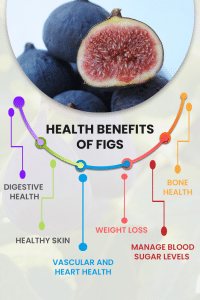Table of Contents
What is a Fig?
A fig is a kind of fruit produced by a typical fig tree (Ficus carica). It’s a fruit that’s sweet and healthy, with soft flesh and lots of small seeds. In the world of fruits, the fig is a bit of mystery packed with a whole lot of nutrients. Never to be forgotten is its power to woo your taste buds. Don’t grab your fork yet; find out the impacts this fruit can have on your wellbeing. As we dig out the downsides and the health benefits of figs in this article, take note of the secrets behind this delightful and fascinating fruit.
Fig Nutrition
Below are the nutritional benefits of dried figs and raw figs.
| Nutrients | Raw figs (100g) | Dried figs (100g) |
| Protein | 0.75 g | 3.3 g |
| Dietary fiber | 2.9 g | 9.8 g |
| Calories | 74 kcal | 249 kcal |
| Iron | 0.37 mg | 2.03 mg |
| Sugar | 16.26 g | 47.92 g |
| Vitamin A | 7 mcg | 0 mcg |
| Vitamin K | 4.7 mcg | 15.6 mcg |
| Vitamin C | 2 mg | 1.2 mg |
| Lipids | 0.3 g | 0.93 g |
| Magnesium | 17 mg | 68 mg |
| Phosphorus | 14 mg | 67 mg |
| Lutein and zeaxanthin | 9 mcg | 32 mcg |
| Potassium | 232 mg | 680 mg |
| Beta-carotene | 85 mcg | 6 mcg |
| Choline | 4.7 mg | 15.8 mg |
| Calcium | 35 mg | 162 mg |
| Folate | 6 mcg |
Health Benefits of Figs
From enhancing bone health to managing sugar levels, figs can have a great impact on your health. Keep up with the read to learn more.

Digestive Health
Fig syrup’s laxative qualities make it a popular treatment for constipation. It lessens the effort required to shift stools and enhances the feeling of an incomplete evacuation. One of the popular benefits of figs soaked in water overnight and consumed with honey is that it can help relieve constipation due to their high fiber.
Vascular and Heart Health
Figs are heart-healthy due to their ability to lower blood triglyceride levels and combat free radicals that can clog arteries. They as well contain phenols and omega-3/omega-6 fatty acids that reduce the risk of heart disease.
Manage Blood Sugar Levels
Dried figs contain chlorogenic acid. Chlorogenic acid can improve glucose metabolism in type II diabetics when part of a balanced diet. They have a moderate impact on blood sugar due to their fiber content. Pairing figs with protein and/or fat in snacks helps maintain fullness and stable blood sugar levels.
Healthy Skin
Dried figs are rich in antioxidants and micronutrients, which promote skin health and strengthen hair. They contain compounds that protect against oxidative damage. This prevents aging and chronic diseases. Other benefits of figs for the skin include their help in preventing bacterial skin infections and strengthening natural defenses.
Weight Loss
Dried figs are a weight-loss-friendly snack due to their high fiber content, promoting satiety and reducing food cravings. They’re a natural and healthier alternative to sugary sweets like cake and chocolate. A 3.5-ounce serving provides nearly 10g of dietary fiber, meeting 40% of the daily requirement and supporting intestinal health.
Bone Health
Figs, rich in calcium, magnesium, strontium, phosphorus, and potassium, are a nutritious fruit that can reduce bone thinning and osteoporosis risk. In turn, they support bone maintenance and growth.
Uses of Figs
Fresh figs
Raw figs are versatile and can be enjoyed as a snack, salad, cheese, smoothie, topping for yogurt, oatmeal, ice cream, preserves or desserts. They can also be made into fig salsa, cheese, nuts, or honey, and cakes. Their sweet and versatile flavor enhances various sweet and savory dishes. They are highly rich in beta-carotene, Vitamin A and Vitamin C.
Dried figs
Dried figs are calorie-dense, high in natural sweetness, and contain no added sugars. Therefore, they are a healthier alternative to processed foods like cookies and cake.
During breakfast
Looking to improve your breakfast? Try adding sliced figs and a touch of honey or maple syrup to your oatmeal, pancakes, or waffles for a delicious twist. However, be mindful of your fig consumption, especially if you have health issues.
How to Eat Figs or Add Them to Your Diet
When adding figs to your diet, be considerate of the form you choose, as dried figs are higher in sugar and calories compared to fresh ones. Incorporating figs into your meals can bring a touch of sweetness and nutritional value to your diet. Let’s talk about four different ways you can add figs to your diet:
-
Fresh Figs
Fresh figs are a low-calorie, healthy snack, perfect for salads, desserts, and even making fig jam or preserves for spreads or toppings. They also offer a sweet twist. A couple of fresh figs per day can be a reasonable portion.
-
Dried Figs
Dried figs, despite being higher in sugar and calories, are a nutritious and delicious snack option. They are known for their natural sweetness and potential effectiveness in treating constipation. It is beneficial to limit your intake of dried figs to about 2-3 dried figs per day to manage your calorie and sugar intake.
-
Fig Leaves
Fig leaves, a nutritious and unique culinary experience, are often used as wraps for rice, meat, or other fillings, similar to grape leaves found in specialty grocers. The quantity of fig leaves used in a recipe depends on the specific dish and your personal preference.
-
Fig Leaf Tea
Fig leaf tea, a soothing and aromatic beverage made from dried fig leaves, offers potential health benefits, including blood sugar levels, and can be enjoyed daily. It’s advised to enjoy it in moderation and not exceed more than a few cups per day.
Fig Recipes You Should Try
Below are different ways you can experiment with this delicious and versatile fruit.
-
In Baking
Fig and Walnut Bread: Incorporate chopped dried figs and walnuts into your favorite bread recipe for a delicious and slightly sweet loaf.
-
In Breakfasts
Fig Smoothie: This is yet another way to bless your taste buds with a tasty and nutritious blend. If you’re a lover of morning smoothies, try blending figs with bananas, spinach, and almond milk.
-
In Salads
Quinoa and Fig Salad: Mix cooked quinoa with diced figs, chopped mint, and a lemon vinaigrette to get a refreshing side dish.
-
With Cheese
Grilled Cheese and Fig Sandwich: You can add sliced figs to your grilled cheese sandwich for a sweet and savory twist on a classic level.
Downsides
- Laxative action
Figs are known to have a mild laxative effect due to their high fiber content. They promote regular bowel movements and relieve constipation in some individuals. However, the laxative effect differs from person to person, and excessive consumption of figs can lead to diarrhea.
- High level of vitamin K
If you’re taking blood-thinning medications, it’s important to maintain a consistent intake of vitamin K-rich foods, including figs. Vitamin K plays a role in blood clotting, and varying your intake of vitamin K-rich foods can affect the effectiveness of blood thinners.
- Allergy
Figs can cause allergies in some individuals. People who are allergic to birch pollen may be more susceptible to developing a fig allergy due to cross-reactivity between the two. Additionally, the latex found in fig trees can also trigger allergic reactions in some cases. If you suspect a fig allergy, immediately consult with a healthcare professional for proper evaluation and guidance.
The bottom Line
This article highlights how figs can be a beneficial part of a balanced diet. Dried figs are a natural source of calcium, energy, magnesium and other vital minerals. To derive their health benefits, incorporate them into various meals and snacks throughout the day.
If you enjoyed this article and know the great health benefits of Figs like and share it. Your Sarah Evans


